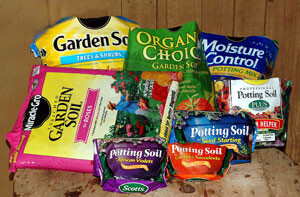Every time I go to the garden center or nursery, I’m amazed at the number of soil products available. There are bags for seeding, bags for potting, bags for containers, transplanting, cactus, violets, with fertilizer and without, etc. You get my point. Who would have thought dirt would come to this?

As astute gardeners, we can appreciate that all soil was not created equal, and for good reason. But do we really need so many options? Designer soil lines seem to be one of the hottest products in home gardening. You can credit that to good marketing and our busy life styles. The answer is, no we don’t need so many choices. If you look at the ingredients on most of these products, you’ll be surprised to find they all include most of the same components.
Potting soil or soilless?
One of the biggest terms to note is the difference between “soil” and “Soilless” blends. Soilless blends are used for starting seeds and seedlings. These mixes are usually a combination of peat moss, perlite, and vermiculite. It is called soil less because it does not contain organic material that might contain harmful pathogens that could harm or kill tender seedlings. These products have been pasteurized, or heated to a very high temperature so that any potentially harmful pathogens have been killed. Soilless mixes are the best choice for starting seeds. They are also the lightest in weight and density, which is necessary for giving seeds the best chance of a good start.
The rest of the soils including potting or container mixes usually include peat moss, perlite, and “composted natural products”. This last component varies from region to region. It depends on where the product was made, and what was available. Consider it a catchall phrase. The biggest variable is the percentage of each. These products are designed to be light enough to allow for good drainage, yet maintain some water holding capacity. This is a good combination for container type plants. To customize designer soils even more, manufacturers add variables such as slow release fertilizers, and water holding polymers that absorb water and make it available to the plant roots over extended periods.
In my opinion, the biggest advantage to the wide range of designer soils available today is convenience. To be sure, they are fine products. If you’re looking to save time or don’t want to think about it, designer soils are just what you need. However, a basic understanding of soil, plant needs, and fertilization can get you a lot of mileage in creating your own custom blend and save a few dollars in the process.